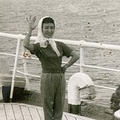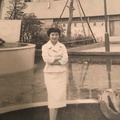The plummeting bomb missed its aiming point, a T-shaped bridge below with pronounced visibility from the sky by 800 ft, being pushed off course by a hard crosswind. It descended nearly 6 miles in 43 seconds until erupting at 1,900 ft. over a nearby hospital, just 500 ft. from the Prefectural Industrial Promotional Hall, sending out a multidirectional airburst of uncontrollable energy throughout the predominantly flat landscape.
Lilly along with her mom were soon trapped underneath their home, eventually crawling out at the same time while saving her two-year old sister trapped unconscious beneath a cabinet, just escaping their home engulfed in flames. Luckily her father, recovering at an outlying hospital from Typhoid fever accompanied by his middle daughter, was not hurt. Lilly, in dismay of what just occurred, looked as far as she could see through the dust and debris that filled the air over a city immersed by fire. She wanted to deny any notion that her home and city were destroyed, except that was all an afterthought as she somberly stood staring out.
This bomb exploded with the equivalent of 13-15 thousand tons of TNT purposely built to cause destruction by blast, fire, and successive radiation. The Enola Gay, which had promptly circled for two minutes after the bomb’s release, performed a rapid hard right slant retreat away. The blast was so powerful that it shook and fully blinded the B-29 crew, now wearing black tinted goggles and were 11.5 miles away. It was additionally noted that the pilot with his back to the explosion observed a silver blue flash out the corner of his eye, followed by a strange galvanic shock sensation in his mouth of drilled dental fillings.
The bomb’s detonation in the first one-millionth of a second composed an estimated peak temperature in the epicenter of over one million degrees Fahrenheit. The explosion was followed by a light emitting ten times the brightness of the sun, thereby forming an immense fireball.
In addition to a massive heat and blast force, mass amounts of harmful radiation were expelled. Seconds later, the bomb’s illuminated X-ray-heated air just above ground and expanded rapidly at the same time, sending invisible shock waves in all directions within a one-mile radius. The produced fireball continued to grow with the air’s velocity greater than the speed of sound, with created pressure more than 30 times needed to cause death. This wall of high pressure left a vacuum eliminating all oxygen, and the nuclear thermal or heat energy reached its highest point. Lastly, the fireball increased to nearly one thousand feet in diameter, now traveling one thousand miles per hour, quickly moved through town and rebounded off the northern mountain range all within seconds.
Near the detonation point, some buildings that sat directly beneath the blast and concrete reinforced for earthquake stability were spared, preventing their framework from fully collapsing. Mainly, this odd structural resistance was the result of the bomb’s predominate outward burst explosion versus down directed. Other steel-framed buildings abruptly liquified like wax. Outside the center, homes and businesses constructed of the commonly used timber frames and paper inevitably increased the magnitude of the already intense fire to a multiple mile radius.
The historic and sacred Hiroshima Castle, a 350-year-old temple style structure and headquarters of the 2nd General Army, was half a mile away from the focal point and had succumbed to the fires. The castle was an iconic symbol of the city, as well as the previous home of the feudal lord that Lilly’s samurai ancestors operated under.
The intensity per reports resulted in 60,000-70,000 people vanishing instantly and another 140,000 injured, mostly comprised of severe flash burns. On top of this, U.S. military prisoners of war along with multiple Japanese American citizens were a part of those statistics.
The bomb that eventually created a massive mushroom cloud of purple and gray smoke, together with a burning red core high into the sky, was purposely dropped at the busiest time of day. It created silence at ground zero on account of no buildings left to crumble, trees to fall, or life existing. The bright sunny morning had now turned dark, and the city was entirely covered by a canvas of only black, brown and red colors.
Amazingly, even with the catastrophic damage, it was later determined the bomb was very insufficient as only less than two percent of the uranium reacted. The amount that generated this level of destruction weighed less than the U.S. dollar bill.
Once Lilly and her family escaped from their home’s rubble, she and her mother swiftly and eagerly began searching to locate survivors. Many struggled, trapped in burning buildings or under the rubble violently screaming. While Lilly was searching, feeling confused and being driven by instinct, she quickly ran towards the bicycle shop in hopes of being able to peddle back to her workplace. While running, the shop became clearly visible in the distance by the images of melted bicycles.
She vividly recalled to mind making that short journey to and from the shop, creating mental snapshots of people on street benches along with streetcar riders sitting and standing charred stiff. Not to mention, still etched in her mind were the human shadows burned onto the streets, sidewalks, and surviving portions of buildings. Innumerable Hiroshima citizens were walking and then abruptly incinerated by the heat, leaving only their body’s permanent outline for a remembrance.
One traumatizing image forever remembered, the shop owner himself was spread below his body’s outline only as a pile of ashes. In a few places, it was too hot to imprint any shadows, as metal and stone fixtures just sat bubbling. One survivor’s eye-witness account of this dramatic event recalled looking up to the sky and seeing an object that was initially about the size of a grain of rice, tinged with yellow and red that continuously grew into a massive fireball heading earthbound to engulf anything in its path.
Lilly distinctly thought back on survivors comprised of third-degree burns walking the streets naked or clothes scorched to their skin, especially dark pattern colors. Thus, women wearing kimonos had flower outlines tattooed to their skin, although those wearing white colors experienced slightly less severity. She watched numerous victims incoherently begging for help, mostly just wanting water to quench their overwhelming thirst. Others were observed walking or crawling in every direction, their skin hanging from their bodies. There was despair from the many images of faces and arms combined with the sulfurous odor of burnt eyebrows and hair.
Lilly saw countless number of the innocent stumbling around in a severely traumatized state, sometimes vomiting with each step. Due to the fervent pain they walked with their arms out, elbows bent and hands dangling, resembling a real-life zombie or scarecrow. She reflected on multiple other survivors eager to escape the heat and to soothe their burns, jumping into the nearby Ota River and splitting water channels. Most drowned or died in minutes. The waterways were encompassed of—or should I say plugged up with—thousands of bodies including horses, a major transportation means of the police and citizens. Thus in the ensuing days, thousands of bobbing corpses floated back on shore each high tide.
Later, Lilly walked through town searching for relatives, except they were not to be found. She began walking toward the Prefectural Industrial Promotional Hall to check on her co-workers, lacking premonition of the haunting images she was about to see. Injured and severely confused children were seen crying out for their mothers that were dead or severely injured.
Upon walking she passed a young injured mother, a barely recognizable neighbor who was still carrying her tightly bound infant on her back in a traditional Japanese style, just like she had done moments before the explosion. The neighbor—probably in a state of shock, because the baby was completely black, shriveled, and deceased—asked if her baby was alright. Lilly replied with a somber ‘yes’; sadly, Lilly later found out that her neighbor went on to die a week later.
Once arriving at Lilly’s first-floor workplace, she identified piles of ashes where her co-workers once sat, proceeded by the vivid scene of her large metal typewriter resting on her partially standing desk completely liquified. She continued to search near the Prefectural Industrial Promotional Hall in anticipation of survivors and identifiable bodies each day amidst the next month, yet her search was unsuccessful. Downtown Hiroshima was such a vibrant place, but life stopped in an instant; time literally stood still, as watches later found at the epicenter shown hands frozen at 8:15.
Subsequently as the day went on, Lilly and her family took refuge in a shelter that was converted into a makeshift first aid station. These shelters, set up at the various local schools, quickly began to fill up as myriads of orphaned children and the elderly who just sat with no one to give them care. The downtown hospitals were transformed to ruins, resulting in the passing away of more than 90 percent of their doctors and nurses. The remaining medical, food, and water supplies being rationed because of the war were inadvertently contaminated by the bomb’s radiation and, consequently, the black rain that began to fall.
People were consumed with feelings of desperation, combined with uncontrollable thirst resulting from their burns. The August heat was unbearable, and at the same time there was little water. The only main supplies left to treat injuries and burns were cloth bandages, vegetable oil, and aloe with household chopsticks used to help clean any burn or lacerated wounds. Lilly looked back on feverishly using a traditional mixture of wood ash and oil in an attempt to soothe the pain of those inflicted with severe burns.
Upon sunset that August night, abundant were those with severe burns who could only moan as they lie on straw mats, hoping to obtain any type of comfort. Lilly recounted being at a shelter consoling a severely burned woman who asked if her baby had survived, a growing concern she was witnessing of many mothers. Lilly had seen the baby just prior, now dead, appearing very bloated and disfigured from critical burns. In concern, she told the woman that the baby did survive just to give solace as she lie suffering, until finally succumbing to her burns a few days later.
The instant loss of life numbers was staggering. During the succeeding days, weeks, and months, however, an insurmountable number of citizens succumbed to their burns and injuries, not to mention alarming malnutrition.
Lilly recalled that in the mid-August Hiroshima heat, multitudes of corpses immediately began to decompose and smell. The sanitation and hygiene control were nonexistent, and these issues resulted in the city soon becoming overwhelmed by the infestation of flies and ants. In the absence of proper shelter, medicine, and bandages, flies swarmed open wounds creating infection and maggot infestations. Lilly described her frustration of constantly swatting the never-ending raucous flies away from an infected eye laceration and brushing off numerous crawling ants.
To combat this problem, aid workers quickly cremated the deceased bodies without even confirming their identities. Lilly easily brought back images of the many piles of bodies seen, and the smoke later rising from the around-the-clock cremation fires that subsequently emerged.
© 2022 Jon Stroud












